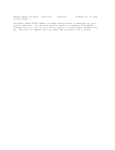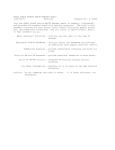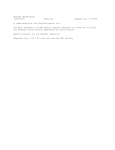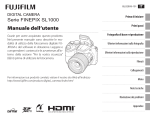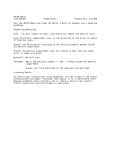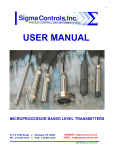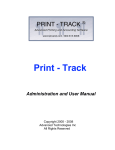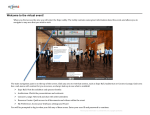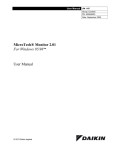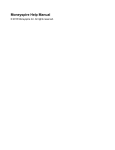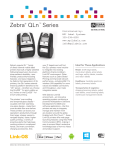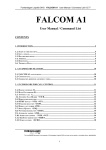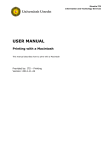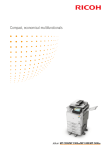Download Integrating Fax Into Microsoft Office
Transcript
An IT Briefing produced by Technology Update: Integrating Fax into Microsoft Office Environments Sponsored By: Technology Update: Integrating Fax into Microsoft Office Environments By Lloyd Johnson and Peter Davidson BIOS © 2004 TechTarget Peter Davidson—President of Davidson Consulting. Mr. Davidson has 23 years experience and has published market research reports for International Data Corporation, Yankee Group and International Resource Development. He has recently written and published these two reports: Computer-Based Fax Markets, 2003–2008, and Fax, E-mail and Voice Messaging Services. Davidson Consulting publishes market research and newsletters on facsimile, unified messaging and strategic information delivery. The company also provides custom consulting in these areas. Lloyd Johnson—Vice President of Development at FaxBack. In 1991, Mr. Johnson founded CommercePath, a leader in providing print automation solutions to Fortune 5000 companies. The company was purchased by AVT/Captaris in 1998. An early offering of this product was Internetlink, the first commercially available solution that enabled production documents such as invoices to be delivered as e-mail attachments. CommercePath won the award for Best Production Fax Server for four successive years. Mr. Johnson graduated in 1974 from Pacific Lutheran University with a Bachelor’s degree in Business Administration. This IT Briefing is based on a FaxBack/TechTarget Webcast, “Technology Update: Integrating Fax into Microsoft Office Environments.” To view this Webcast online, please click the link. This TechTarget IT Briefing covers the following topics: • Fax Server Markets, 2003–2008 . . . . . . . . . . . . . . . . . . . . . . . . . . . . . 1 • Fax Integration . . . . . . . . . . . . . . . . . . . . . . . . . . . . . . . . . . . . . . . . . . 2 • An Overview of NET SatisFAXtion. . . . . . . . . . . . . . . . . . . . . . . . . . . 4 • How NET SatisFAXtion Works in Outlook . . . . . . . . . . . . . . . . . . . . . 5 • The Ins and Outs of Inbound Faxes . . . . . . . . . . . . . . . . . . . . . . . . . 6 • Fax Over IP Makes a Resurgence. . . . . . . . . . . . . . . . . . . . . . . . . . . . . 7 • Tight Integration with Microsoft Office. . . . . . . . . . . . . . . . . . . . . . . 8 Copyright © FaxBack 2004. All Rights Reserved. All trademarks are the property of their respective owners. Specifications subject to change. About FaxBack For over 20 years, FaxBack has been providing award-winning fax servers, fax-on-demand, broadcasting and web-to-fax solutions, at a lower cost of ownership than comparable fax servers. NET SatisFAXtion provides Microsoft Office and Outlook fax integration. So whether you are evaluating, looking for more information or need advice on how to get the most out of products you already own, you will find what you need to fax smarter by visiting www.faxback.com/landing/bob. There you will find a range of white papers, product sheets, case studies, and software trial downloads, or call at 1-800-329-2225, ext. 5350. About TechTarget IT Briefings TechTarget IT Briefings provide the pertinent information that senior-level IT executives and managers need to make educated purchasing decisions. Originating from our industry-leading Vendor Connection and Expert Webcasts, TechTarget-produced IT Briefings turn webcasts into easy-to-follow technical briefs, similar to a white paper. Design Copyright ©2004 TechTarget. All rights reserved. For inquiries and additional information, contact: Dottie Luce Manager of Webcasts, TechTarget [email protected] Technology Update: Integrating Fax into Microsoft Office Environments Fax Server Markets, 2003–2008 Faxing offers a secure method of transmission and every time a fax is sent it is confirmed or an error report is generated if it doesn’t arrive. Faxes cannot carry viruses like e-mail can and they cannot be used to phish. Therefore, faxes cannot be used to harm a company’s security in any way. The factors that are driving fax server markets; the number one factor is compliance issues. There are regulations such as the Health Information Protection Act (HIPPA), and there are others in financial services and so on, and companies are installing fax servers very rapidly trying to keep up with these compliance issues. The second major driver for fax server is that e-mail is broken and this is because, number one there are viruses hitting e-mail all the time, which makes people uncertain whether they want to open e-mail attachments, and phishing and so on and so forth, and e-mail has got tremendous problems right now, and faxing doesn’t. So, fax is always up in that case and is continuing to survive for that reason. The third factor for fax server growth relates to IT consolidation. Traditionally network fax servers have been implemented by a workgroup or purchased on a department-by-department basis. Where we saw, 5-10 years ago, departments like HR, Purchasing, and Sales deploying fax solutions that fit their specific needs, today and for the last couple of years the trend has been toward standardizing on a single source fax solution. The fourth factor is production fax. Unlike broadcasting, when you send out to 3,000 people with production fax, you can deliver a highly personalized document via a variety of methods including fax, e-mail, mailgram, or print—whether it is an invoice, proof of receipt/purchase and more. A good example of production fax is where purchase orders are set up and then the fax server sends out a unique purchase order to everybody on the lists right away with a few simple clicks of a print button. Another capability that’s pushing fax servers is workflow, so if somebody calls into a fax number, the fax server figures out whether what region the person is from and automat- 1 ically directs it to the appropriate rep to take the order and so forth. In terms of fax server market hurdles, the biggest hurdle right now is the FCC, which has created challenges for the fax industry by making unsolicited fax illegal without signed written consent from the recipient. Now the FCC wants to do this because of people who were sending junk faxes, but now if someone wants to send a fax broadcast as of January 1st of next year, that person will have to have the signature of everybody he or she wants to send a fax to and needs the signatures. This is a real hassle for people who are sending out faxes, however, the fax vendors are offering tools so that signatures can be automatically generated for the list. Another hurdle for faxes is that they are made of TIFF files, which is an image file and if someone wants the alphanumerics in the image to be added in order to reply to the fax and so on, they will need Optical Character Recognition. And so that brings up a whole issue that makes faxes not quite as easy to respond to as e-mails. Finally, there is a belief among many people that the fax is obsolete. Then there are fax server benefits versus fax machines. People don’t have to leave their desks to fax. The fax integrates with e-mail and can be sent directly from a person’s computer, and faxes can be received directly to the computer as well. Production fax is not possible with traditional fax machines in that they are not designed to send highly personalized documents on the fly via several different delivery methods like fax, email, mailgram, and print. With production fax, a company sets up “rules” of delivery so that, if they send a batch of 3,000 invoices, they can simply “print” to have the invoices instantly personalized and delivered without any manual intervention. Another market-driving factor is that production fax is allowing companies to deliver documents very strategically—not simply via fax, but through other delivery vehicles such as print, e-mail, and mailgram. Here are a couple of results from the report on fax servers. In inbound routing, 76% of people who bought fax servers a year ago use inbound routing. Probably 75% or 80% of those use direct inward dial. IT Briefing: Technology Update: Integrating Fax into Microsoft Office Environments Sponsored By: The other capability is e-mail integration, where 9 out of 10 users at this point are integrating fax with e-mail. Twenty-five percent of faxes are sent as paper, which means vendors are linking to Multi-Functional Peripherals. Xerox, Canon, Hewlett Packard, and Ricoh combined sell the largest number of multifunctionals. Vendors are linking to MFPs, so users can send paper documents from the machine and it goes out over the fax server. This is a nice feature because then someone can receive reports via e-mail. The future of fax is the T.38 Internet fax. T.38—also called “FoIP” or Fax over IP—is an industry term that has been around the last 5 years or so that is starting to make some noise, especially with more and more companies implementing “VoIP” solutions (Voice over IP). Most companies deploy VoIP/FoIP solutions in order to save money. FoIP solutions do not require the expensive fax hardware traditionally needed when deploying a fax server. Cisco routers, for example, include VoIP and FoIP capabilities, allowing companies that would like to implement network fax technology to save money on buying fax hardware. There is another type of Internet fax T.37, which uses store and forward mechanisms, it’s sort of like e-mail. The way it works is an Internet fax is sent, it bounces around the Internet and then it finally arrives at its destination. There is no connection between the sending point and the receiving point, which means that you don’t know whether or not you get reports. So real-time fax uses a store and forward environment. It is essentially the same as voice over the Internet, which is usually when it’s used as well. In 2003, just over $250 million worth of fax servers were sold, and that’s going to grow about 8% a year and so in 2008, we are going to see sales of $410 million that will turn around the fax server market, because a few years ago it was slightly in decline and now it’s not. Research shows that the time it takes to send a manual fax is 10 minutes. That sounds like a lot of time, but when looking at the components of it such as printing the document to a network printer, walking to the printer to pick it up, taking it to the fax machine, filling out a cover page, sending the document, probably resending the document because the number is busy and then walk back to a desk—that time takes 10 minutes. That doesn’t include time for chatting, stopping for coffee and other distractions. So sending a manual fax is a very time-consuming 2 process and after that what has been delivered is a very ordinary, very unattractive, hard-to-read manual fax. That also means a person has sent a message to a trading partner and a reminder to himself that the company has not integrated fax into the workplace. Sending outbound manual faxes is synonymous with wasting time and therefore wasting money. It also adds to the masses of paper that plague most offices. If you were to walk to your fax machine now and take a look at it, it’s probably surrounded by paper— maybe two stacks of incoming and outgoing faxes. Almost all of that paper there is worthless. But somewhere in that stack is a missing document that is critical and needs to be reviewed by someone. And that’s not the only problem. Studies have shown that over 90% of all faxes that are sent manually are sent in the standard mode, which means color and grey scale will often go to black. Often, the fax will be twisted. It hasn’t gone through the fax machine straight. There’s often a dirty plate, with dust on the scanner head and so someone has sent a document that doesn’t look very good. Many companies spend a lot of money trying to create a professional corporate image. Delivering documents that do not meet those standards can undermine these efforts. But outbound faxing isn’t the only problem with the manual process. If faxes are received from a manual fax machine it has its own set of challenges. Timeliness is the biggest of these challenges. With no notification that a company has received the fax, it could be minutes, hours or days before someone takes the effort to deliver a document that was sitting on a fax machine. Chances are the document will end up in that pile of papers. Also someone might walk up to that manual fax machine and take that page thinking it was their fax, and put it in a file not knowing that the bottom page was meant for someone else. So there has to be a better solution and that is integrating fax into an office environment. This can solve all of these problems. Fax Integration Most companies are focused on spending unbudgeted funds on solutions that will have an ROI that is very compelling as well as increasing worker productivity. The solution has to be universally available to employees, customers and vendors. An organization may use ETI or perhaps you use XML. These are both wonderful technologies for exchanging documents IT Briefing: Technology Update: Integrating Fax into Microsoft Office Environments Sponsored By: Figure 1 Figure 2 3 IT Briefing: Technology Update: Integrating Fax into Microsoft Office Environments Sponsored By: and information with trading partners, but both of those technologies are most likely only reaching 20% of a company’s trading partners that can actually take those documents. So they need to turn to something that can be universally used. The idea is a single solution that can be used by different departments and be flexible enough so that each department can use those according to their own needs. The company must be able to install the server quickly and without the resources of IT department. If IT is called and asked to help with the installation and it's not on their schedule, they are most likely going to say no, or just to get in line. So the solution must be deployed across the enterprise and quickly provide user documentation, so that the users themselves can become completely self-sufficient. They shouldn’t have to call either IT for technical support or the vendor. So, the support and the documentation for whatever client solutions they might use needs to be at their fingertips. A company might have an IP telephony initiative, and Fax over IP must be part of that solution. This is the future of faxing. An Overview of NET SatisFAXtion As previously stated, 25% of all documents to be faxed are paper documents and the solution must be able to accommodate them. These are all reasonable requirements and FaxBack has built a solution designed to satisfy all these requirements and much more. That solution is called NET SatisFAXtion. FaxBack is the only fax company that has solutions for every fax product line, including networks fax servers, Fax-on-demand, Fax over IP, Web fax, Web page faxing, fax broadcasting and faxing using an API. Through the many years, FaxBack has installed thousands of fax servers to customers all over the world and has had its share of accomplishments. Many people are familiar with WinFax PRO. WinFax engineers built WinFax PRO for Networks for Delrina Symantec in the mid 1990s. Chances are a company would have used AT&T’s e-mail to fax gateway, which FaxBack built for them. FaxBack also developed NET SatisFAXtion in 1990 for Intel, which was bundled with their SatisFAXtion fax cards. These three events Figure 3 4 IT Briefing: Technology Update: Integrating Fax into Microsoft Office Environments Sponsored By: were largely responsible for the phenomenal growth in fax. Along the way, FaxBack garnered many awards, most recently Windows.Net magazine’s Reader’s choice award last year. FaxBack is now installed in thousands of installations from small-sized businesses to Fortune 100 global companies. It is the first fax server to support V.34 and JBIG compression. These technologies are relatively new and they allow a company to slash delivery times 20% to 80%, which brings a big reduction in the cost of faxing. FaxBack is the first company to introduce new technologies; its fax server is built on Microsoft.Net technology. This combined with web services, XML, SQL back-end, provides a very robust and feature-rich environment. FaxBack is the largest fax-on-demand installation in the world; the Internal Revenue Service has hundreds of lines and delivers up to 60,000 fax forms a day during peak season. Fax technology has been around a long time, which is why many people may be wondering if fax isn’t just yesterday’s news. But it definitely isn’t. With the number of spam e-mails out there, fax has gotten new legs. It’s estimated that e-mail has become very unreliable as a way of delivering documents. More than 50% of all email is spam, and 20% of e-mail is automatically rejected because of spam filters. So fax, although it has been around for many years and did go through a period of potential decline, is now growing at a rate that is close to what it was in the earlier years. FaxBack believes NET SatisFAXtion is a leading fax server for Microsoft Office Integrations, tightly integrated with all the applications and very tightly integrated with Outlook for Unified Messaging. A person can either send faxes without ever leaving Outlook or fax directly from any application. For example, if someone is in an application such as Microsoft Word, if a cc: is going to file print, it prints to a FaxBack fax driver. This is going to create an attachment and launch a new e-mail message with that attachment attached. A user can combine documents into a single fax for multiple sources. If, for example, a person wants to create a Microsoft Word document but also include a PDF file, those documents are multiple attachments to this message and they will go as a single fax. Inbound faxes can also be routed directly to personal e-mail inboxes and this is where Unified Messaging would come in. It is the easiest system to both install and to deploy. The installation is MSI-resilient, which is self-repairing, which means that whenever the fax server starts, it’s going to check the integrity of the 5 different files that are used to make the fax server. If any of them are damaged, corrupted or missing the software will reinstall those pieces and it will be up and running again. NET SatisFAXtion installs a web server and installs a web site called the Launch Pad, which can be used both by administrators and users. There are e-mail gateways and various things that can be installed by an administrator. Users can simply browse through their Launch Pad and see a variety of applications that are available to them. FaxBack has thick clients, thin clients, e-mail addressing helpers, and real time monitors, and each of these clients has its own page that describes both the function of the application and provides full documentation for using it. A single-click installs an MSI program that allows client technology to be instantly deployed. Since these are MSI programs, these clients can also be deployed through push technology, such as Microsoft F&F. Also included in the launch pad are support pages, which include the full user manual not only for the clients but for the entire operation of the server. It also provides a way to search FaxBack’s online database. So this is an exceptionally easy way to deploy the solutions and eliminates the need to send someone around with a CD. No one wants to e-mail executables because Outlook is most likely going to block them anyway. So outbound faxing from Microsoft Office couldn’t be any easier: you just print your fax from any Microsoft Office application or any Windows-based application. How NET SatisFAXtion Works in Outlook The document is rendered for faxing and attached to a new fax message in Outlook. A user could also start in Microsoft Outlook. When NET SatisFAXtion is installed along with an e-mail gateway, and the client software can be automatically installed along with utilities that will help him address his document. The first thing it’s going to do is understand which of the different addressing message has been used. For example if someone installs an exchange connector, he or she would need to address that document differently than if they installed an SMTP or a POP3 connector. Once the fax server is loaded and the client installs the software from the NET SatisFAXtion Launch Pad site, e-mail addressing templates are installed. Only the e-mail addressing templates that are appropriate for what the user has installed as an IT Briefing: Technology Update: Integrating Fax into Microsoft Office Environments Sponsored By: e-mail client are installed. So, for example, if an Outlook user downloads from the Launch Pad, only the Outlook addressing templates will be installed. NET SatisFAXtion integrates directly with a user's e-mail client so that a “Fax” button appears within their e-mail application. This allows them to simply click on the “Fax” icon button to send a fax. The whole point of installing address helpers is that you’re making it extremely easy for your end-users— whatever their various skill-sets are—to send a fax right from their e-mail applications. Addressing an e-mail as a fax message is as simple as clicking on the “Create a new message” button that allows you to send a new email and now—with the address helpers installed—a fax. If the user has populated the business fax field with a fax number, he or she can simply select a user and that number would be the fax number for the document. If there isn't a contact record for the person a user wants to send a fax to or if this is just simply a one-off fax, the user also can click on “Fax” on the menu, then go to add fax recipients to this message, and a box will appear. The user has done two things: added one contact and prepare to add another contact. By populating the different fields and clicking ‘Add,’ the user can see that it has addressed the document appropriately. The email addressing helper is very important from within Outlook, for example, because users simply have to click on the “Fax” icon button. They are not expected to remember—let alone type —the complicated fax address syntax (i.e., [email protected]). The Ins and Outs of Inbound Faxes There are so many options in inbound faxing. It really requires a more in-depth study of the process. Interested parties are encouraged to visit the FaxBack website and take a look at the white papers on routing faxes. The way it works is when a fax is sent to a company, the phone system routes the fax to the fax server, and passes the last four digits of the fax number that was dialed. The fax server receives the fax, converts it into a PDF document and based on the number that was dialed, looks up and routes that document as an e-mail to the appropriate user. Figure 4 6 IT Briefing: Technology Update: Integrating Fax into Microsoft Office Environments Sponsored By: Inbound routing may use several different techniques. In a small business environment, chances are there will be an analog line used directly from a PBX to the fax server. There might also be DID lines used. DID lines are special lines coming directly from the central office. Enterprises might have been using T1 lines or digital lines; those could be coming either from the central office or from the phone switch. Based on whatever routing configuration a company has set up, with DID routing, users have the ability to have faxes automatically directed to their desktops— with the majority receiving an e-mail message with the fax document as a PDF file attachment. A pop-up alert can flash on the screen to advise them each time a new fax has been received into their e-mail inbox. Fax Over IP Makes a Resurgence Fax over IP is the oldest new technology; something that companies did in 1994. As part of WinFax PRO for Networks, FaxBack built that product to send faxes over a packet switch network so it’s been done for years. In 1999, the T.38 standard became available however it wasn’t until just recently that faxing over IP became mainstream. This is something that people are going to be hearing about a lot more in the future. A company may already be considering or already have in place a Voice over IP strategy. It’s pretty well understood that Voice over IP is the future of computer telephony and nearly any PBX you could buy today is voice-enabled. Many PBX vendors are releasing switches that have no capabilities for traditional handsets at all. If a company has developed a Voice over IP strategy, it still will have to support fax machines, since 100% of the companies use fax in one way or another and they must have the ability to send and receive faxes. Fax over IP (FoIP) is an extension of Voice over IP. In a typical implementation, a fax server delivers a fax over an analog line through the public switch telephone network. With FoIP, the fax instead is delivered through an Ethernet port to a company’s switch, which will have a router, such as a CISCO router. That router has a connection to the public switch telephone network and it is going to make the call to the fax machine. So even though this is Fax over IP, what that means, and this is true of most cases, is the fax is simply going to be delivered to the company’s PBX 7 over IP. At that point it’s going to go over the PSO, an ordinary hot line or at least the public switch telephone network. Now, in some cases, people are putting in a wide area network capability and that could give the company additional savings. What that means is that the fax might be delivered over a wide area network across the Internet to a remote destination, and it gets delivered as a local call. So people will see more and more of this scenario where using wide area network is going to be a way that companies can either reduce or eliminate their cost of faxing. Fax over IP is going to be the future of faxing, and it’s going to definitely give fax new legs. While this may not be something your company needs today, FaxBack believes companies you may be dealing with are committed to it. Since FaxBack was perhaps the leader in Fax over packet networks, it understands the technology, it is committed to it and it wants to lead the parade for fax over the Internet in the future. It is something companies should become aware of and know that FaxBack has the capabilities to support this technology. FaxBack sees NET SatisFAXtion as the number one solution for Microsoft Office integration. The product is fully exchanged with Microsoft Outlook, and every day FaxBack is working to bring new integration to Microsoft applications. FaxBack has a very easy user interface and T-38 has support for Fax over IP. Scanner support is another important area of discussion. NET SatisFAXtion is able to handle the 25% of the documents that start out as paper documents. Faxing paper-based documents comprises a significant enough percentage of what companies are sending. FaxBack has the necessary support for Hewlett Packard’s Digital Sender product line. It can work with the Xerox document centers, and Ricoh’s. These are documents that users can place on the HP Digital Sender and, using the key pad of that sender, put in the fax number and identify who they are, and that document will go through NET SatisFAXtion, which will deliver it, and then send an e-mail back to that user to let them know the status of their fax. Hewlett Packard’s MFPs and Digital Senders offer a convenient, centralized way to capture, archive, and distribute information. When combined with NET SatisFAXtion, they provide a way to save significant time and money when faxing paper-based documents. Many of these MFP devices have fax IT Briefing: Technology Update: Integrating Fax into Microsoft Office Environments Sponsored By: capabilities built within, but are unable to support or provide IP fax functionality. NET SatisFAXtion provides FoIP capabilities allowing companies that have deployed MFP's or Digital Sender devices to take advantage of the enormous cost savings of IP faxing. FaxBack has the ability to work within small businesses enterprises as well. The company has tried to make its system use all of the new technologies such as SQL, dot Net, XML, V.34, since FaxBack sees fax moving strongly throughout this decade, and is trying to make sure that it is built on tomorrow's technologies. FaxBack has turnkey solutions. For small businesses, there is what is known as a fax appliance. A user can just simply plug it into his or her network, install the clients, and start faxing. It’s a perfect solution for companies where IT resources are either limited or unavailable. Large systems are available on rackmannered equipment, provided either by the company or FaxBack can provide that equipment. Tight Integration with Microsoft Office To review, users can continue to do their activities as they have always done. The cost of mailing a document in the case of production documents, such as purchase orders and invoices, is over $2 per page based on the cost of labor, the multi-part forms, and folding them and putting them in envelopes. If these same documents are sent as a fax, they cost a nickel. A user can accomplish in seconds what it takes 10 or more minutes to do if they use manual faxing. Fax is the lowest common denominator. Every customer a company has, every vendor that it works with has a fax machine and everybody knows how to use it. Each user, each department can use the tools that best match the way they work. Installation can take less than 10 minutes. A user can go to the FaxBack website, and download fax NET SatisFAXtion for free, and go through the installation. Users will find it is remarkably simple. Clients are installed by users just browsing. There is a launch pad that’s created as part of the installation or the user can push up the MSNMSI client using SMS server by Microsoft. NET SatisFAXtion has the tightest integration to Microsoft Office and Outlook of any fax vendor. And with respect to fax over IP FaxBack believes it has always and will continue to lead the industry in this new technology. As previously discussed, support for high volume scanners is either available natively or can be accomplished through scripting or through FaxBack’s API. If someone chooses to go with a NET SatisFAXtion solution, he is going to be in good company. FaxBack has been doing this for so many years, and the company has a huge install base. About TechTarget We deliver the information IT pros need to be successful. TechTarget publishes targeted media that address your need for information and resources. Our network of industry-specific Web sites give enterprise IT professionals access to experts and peers, original content and link to relevant information from across the Internet. Our conferences give you access to vendor-neutral, expert commentary and advice on the issues and challenges you face daily. Practical technical advice and expert insights are distributed via more than 100 specialized e-mail newsletters, and our webcasts allow IT pros to ask questions of technical experts in real time. What makes us unique TechTarget is squarely focused on the enterprise IT space. Our team of editors and network of industry experts provide the richest, most relevant content to IT professionals. We leverage the immediacy of the Web, the networking and face-to-face opportunities of conferences, the expert interaction of Webcasts and Web radio, the laser-targeting of e-mail newsletters and the richness and depth of our print media to create compelling and actionable information for enterprise IT professionals. For more information, visit www.techtarget.com. FaxBack_0001_10/2004 8 IT Briefing: Technology Update: Integrating Fax into Microsoft Office Environments Sponsored By:











